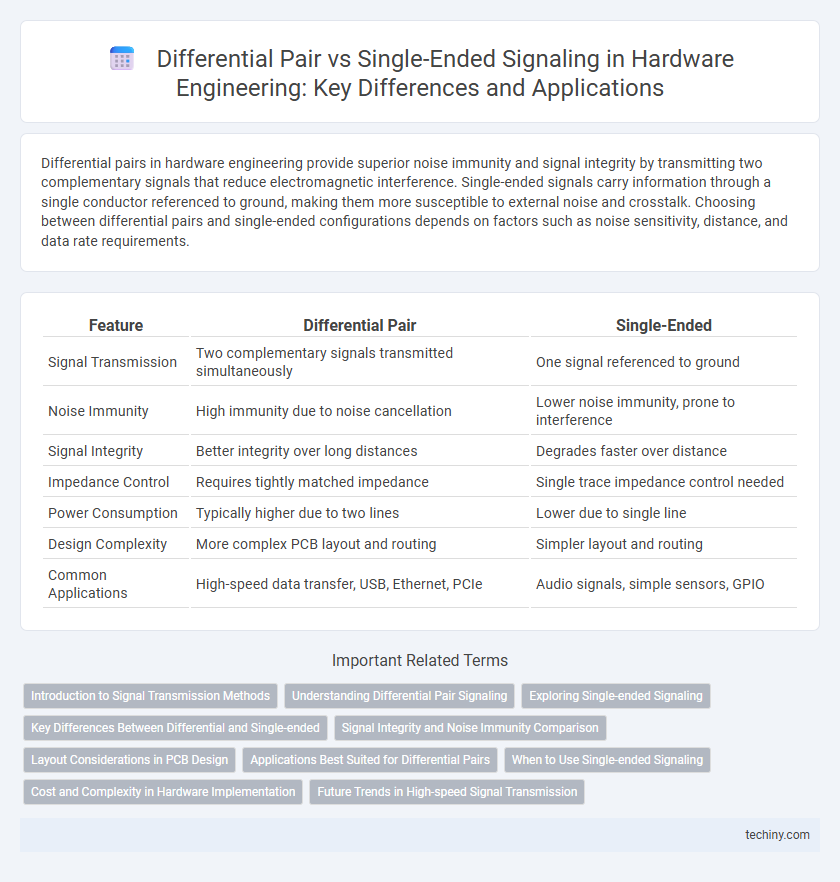Differential pairs in hardware engineering provide superior noise immunity and signal integrity by transmitting two complementary signals that reduce electromagnetic interference. Single-ended signals carry information through a single conductor referenced to ground, making them more susceptible to external noise and crosstalk. Choosing between differential pairs and single-ended configurations depends on factors such as noise sensitivity, distance, and data rate requirements.
Table of Comparison
| Feature | Differential Pair | Single-Ended |
|---|---|---|
| Signal Transmission | Two complementary signals transmitted simultaneously | One signal referenced to ground |
| Noise Immunity | High immunity due to noise cancellation | Lower noise immunity, prone to interference |
| Signal Integrity | Better integrity over long distances | Degrades faster over distance |
| Impedance Control | Requires tightly matched impedance | Single trace impedance control needed |
| Power Consumption | Typically higher due to two lines | Lower due to single line |
| Design Complexity | More complex PCB layout and routing | Simpler layout and routing |
| Common Applications | High-speed data transfer, USB, Ethernet, PCIe | Audio signals, simple sensors, GPIO |
Introduction to Signal Transmission Methods
Differential pair signaling transmits data through two complementary voltages, enhancing noise immunity and signal integrity, making it ideal for high-speed communication. Single-ended signaling uses a single voltage reference relative to ground, which is simpler but more susceptible to electromagnetic interference and crosstalk. In hardware engineering, selecting between differential and single-ended methods depends on the required data rate, noise environment, and system complexity.
Understanding Differential Pair Signaling
Differential pair signaling involves two complementary signals transmitted over paired conductors, which enhances noise immunity and reduces electromagnetic interference compared to single-ended signaling. Each signal in the differential pair carries equal but opposite voltages, allowing the receiver to detect the difference and reject common-mode noise effectively. This method is critical in high-speed data communication and precision hardware engineering, where signal integrity and minimal crosstalk are essential.
Exploring Single-ended Signaling
Single-ended signaling transmits electrical signals using one conductor referenced to a common ground, which simplifies circuit design and reduces board space. This method is cost-effective and suitable for short-distance communication where noise interference is minimal. However, single-ended signals are more susceptible to electromagnetic interference compared to differential pairs, limiting their performance in high-speed or noisy environments.
Key Differences Between Differential and Single-ended
Differential pairs consist of two complementary signals transmitted over paired conductors, providing improved noise immunity and signal integrity compared to single-ended signals, which use one conductor referenced to ground. Differential signaling reduces electromagnetic interference (EMI) and crosstalk by allowing common-mode noise to be canceled out at the receiver. Single-ended designs are simpler and require fewer PCB traces but are more susceptible to noise and signal degradation, especially at high frequencies or long distances.
Signal Integrity and Noise Immunity Comparison
Differential pairs provide superior signal integrity by transmitting complementary signals that cancel out common-mode noise, significantly reducing electromagnetic interference (EMI) and crosstalk compared to single-ended signals. Single-ended signals are more susceptible to noise and signal degradation due to their reliance on a single conductor referenced to ground, making them less effective in high-speed or noisy environments. Differential signaling enhances noise immunity and allows for higher data rates in PCB layouts and interconnects where signal integrity is critical.
Layout Considerations in PCB Design
Differential pair routing in PCB design requires tightly controlled trace impedance and equal trace lengths to minimize noise and ensure signal integrity, unlike single-ended traces which have more relaxed length and spacing requirements. Maintaining consistent spacing and avoiding stubs or sharp bends in differential pairs is critical to reduce electromagnetic interference and crosstalk. Single-ended layouts prioritize reference plane continuity and proper return paths, while differential pairs benefit from balanced routing and ground plane symmetry for optimal performance.
Applications Best Suited for Differential Pairs
Differential pairs excel in high-speed data transmission and noise-sensitive environments due to their inherent noise immunity and reduced electromagnetic interference (EMI). They are widely used in applications such as USB, HDMI, Ethernet, and PCI Express, where signal integrity and minimal crosstalk are critical. The balanced nature of differential signaling makes it ideal for long-distance communication and precision analog measurements in hardware engineering.
When to Use Single-ended Signaling
Single-ended signaling is ideal for short-distance communication where noise susceptibility is minimal and cost reduction is critical. It is commonly used in simpler circuits, such as GPIO interfaces and basic analog sensor connections, where signal integrity demands are lower. Single-ended lines require fewer PCB traces and are easier to route compared to differential pairs, making them suitable for compact, low-speed applications.
Cost and Complexity in Hardware Implementation
Differential pair signaling requires twice the number of traces and associated components compared to single-ended signaling, increasing both PCB real estate and material costs. The need for precise impedance matching and routing symmetry in differential pairs adds design complexity and lengthens development time, often necessitating advanced simulation tools. Single-ended designs are simpler and cheaper to implement but suffer from higher susceptibility to electromagnetic interference, impacting overall system reliability.
Future Trends in High-speed Signal Transmission
Differential pair signaling surpasses single-ended transmission by offering enhanced noise immunity and signal integrity, essential for future high-speed data rates exceeding 10 Gbps. Emerging trends include the integration of advanced equalization techniques and adaptive impedance control to mitigate signal degradation in densely packed PCBs and high-frequency environments. As system requirements evolve towards faster and more reliable communication, differential signaling remains the cornerstone for minimizing crosstalk and electromagnetic interference in next-generation hardware designs.
Differential Pair vs Single-ended Infographic

 techiny.com
techiny.com